Creating an organic garden layout that maintains ecosystem balance is truly exciting. I suggest exploring forest gardens, which mimic natural woodlands, or keyhole gardens, designed for efficiency and accessibility. Raised bed configurations enhance soil health, and companion planting strategies boost diversity and yield. Biomimicry-inspired designs align perfectly with local nature, while layered plantings foster habitats for wildlife. By thoughtfully selecting plants, we can enhance beauty and balance in our gardens. You'll discover even more fascinating design options next!
Quick Takeaways
- Keyhole Garden Design: Incorporates a central composting basket for nutrients, surrounded by raised beds, promoting sustainable practices and efficient water capture.
- Circular Garden Layout: Enhances aesthetic flow and balance, fostering a harmonious environment for plant diversity and wildlife interaction.
- Vertical Gardens: Maximizes limited space while improving air quality and providing habitats for beneficial insects and pollinators.
- Biomimicry Layouts: Mimics natural ecosystems to optimize plant arrangements, encouraging biodiversity and resilience against pests and diseases.
- Layered Planting Structures: Creates diverse habitats by integrating trees, shrubs, and groundcovers, supporting various wildlife and improving soil health.
Permaculture Design Principles
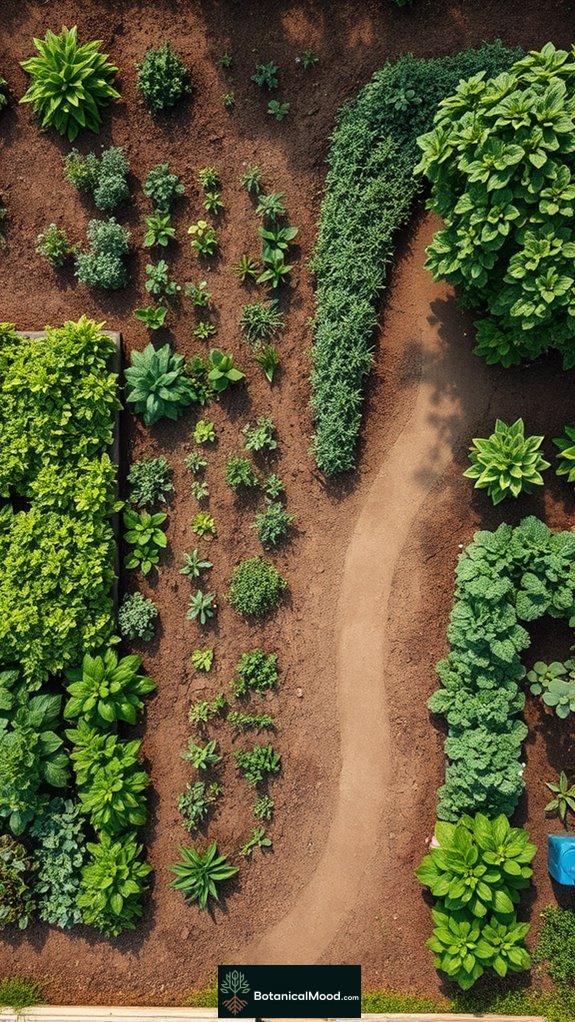
When it comes to designing an organic garden, understanding permaculture principles is essential, as they guide us in creating sustainable and productive spaces. These principles focus on caring for the earth, people, and sharing surplus. I love how they encourage us to observe and interact with ecosystems, allowing us to replicate natural patterns. By organizing our garden into zones—like a cozy herb corner or a bustling crop area—we maximize yields while minimizing waste. Additionally, utilizing guilds in permaculture can enhance biodiversity and promote beneficial relationships among plants and animals. Incorporating permaculture design concepts not only improves productivity but also fosters resilience within the garden ecosystem. Through this website, Botanical Mood, I hope to inspire you to embrace these principles and cultivate a garden that flourishes in harmony with nature's beauty.
Forest Garden Layout
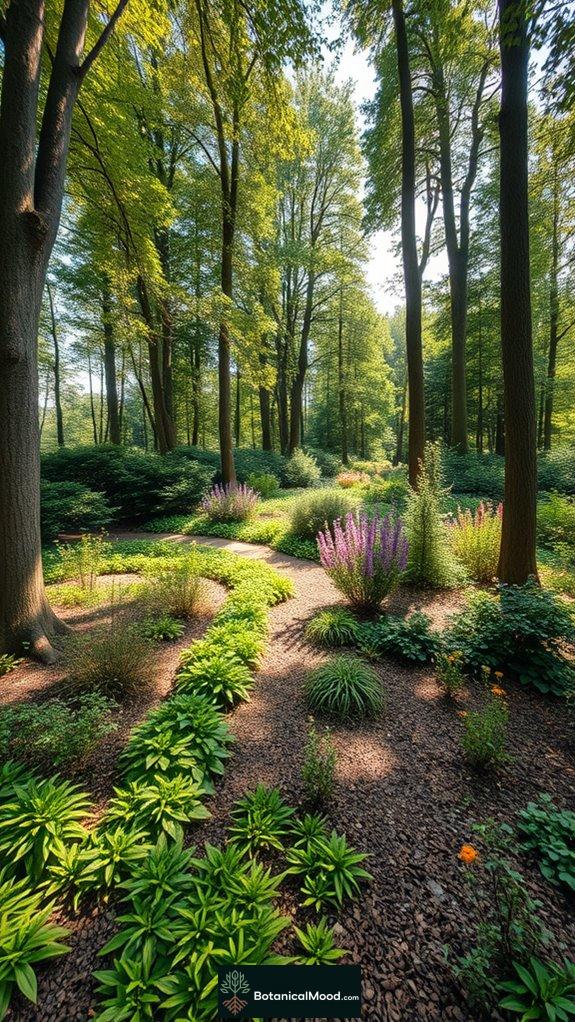
As you explore the concept of forest gardens, you'll discover how they beautifully replicate the complexity of natural ecosystems, creating a vibrant tapestry of life right in your backyard.
In a forest garden, layers intertwine, from towering canopy trees to low-growing ground cover. This design not only nurtures biodiversity but also reduces maintenance.
By selecting native plants, I create habitats for wildlife and enhance soil health naturally. Incorporating pollinator-friendly plants can further support essential species and boost garden productivity.
With careful planning, I can enjoy a year-round food supply while promoting ecological balance.
Through Botanical Mood, I hope to inspire you to initiate your own journey into this enchanting world of sustainable gardening.
Companion Planting Strategies
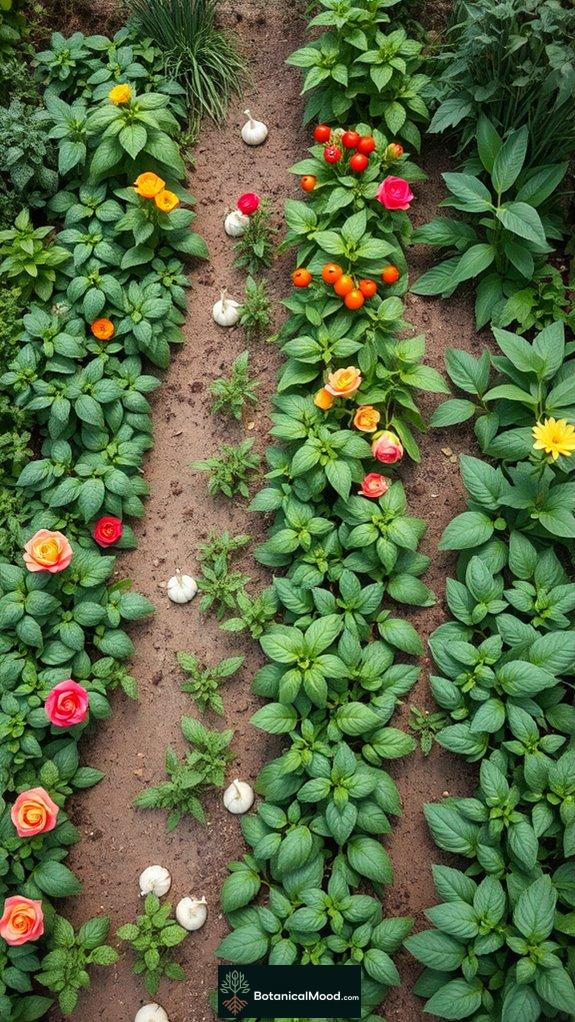
Companion planting strategies can transform your garden into a thriving ecosystem, where plants support each other in a multitude of ways.
Imagine your garden flourishing with:
- Garlic and Roses – Garlic wards off aphids, protecting delicate blooms.
- Tomatoes and Basil – Basil enhances both the growth and flavor of your tomatoes.
- Corn, Squash, and Beans – This trio, known as the "three sisters," nourishes the soil together.
Additionally, incorporating companion planting techniques can maximize space and resources in your raised beds.
Keyhole Garden Design

Keyhole gardens offer a unique and innovative approach to gardening that combines aesthetics with practicality. I've found joy in their design, which maximizes space while promoting sustainability. Additionally, these gardens reflect native wisdom by utilizing regenerative planting techniques that enhance soil health.
Here's a quick look at the key features:
| Feature | Description |
|---|---|
| Central Composting Basket | Nutrient source and water reservoir |
| Design Variability | Round or rectangular shapes based on space |
| Accessibility Pathway | Narrow paths to maintain soil structure |
| Raised Bed Construction | Made from wood or wire mesh for easy maintenance |
| Rainwater Management | Efficient capture and distribution of rainwater |
These elements create a harmonious garden that thrives beautifully.
Raised Bed Configurations

Raised bed configurations are a fantastic way to optimize your gardening space, allowing for creativity while ensuring practicality.
Here are three configurations that I love:
- Rectangular Layouts: Perfect for a variety of plants, they maximize space while maintaining accessibility.
- Circular Designs: These create a lovely focal point, ideal for decorative flowers or small trees.
- Tiered Gardens: They're perfect for sloped yards, giving each plant its own little ecosystem. Additionally, modular raised garden beds offer flexibility in design and can easily adapt to different spaces and plant types.
Hugelkultur Bed Arrangements

When it comes to creating stunning and functional garden spaces, Hugelkultur bed arrangements stand out as an innovative solution that combines aesthetics with ecological benefits.
These versatile beds can take on any shape—round, hexagonal, or rectangular—allowing for personalized designs that resonate with your vision.
I love how the logs retain moisture, nurturing a rich environment for plant growth. As they decompose, the soil improves, ensuring long-term productivity.
Spiral Herb Garden
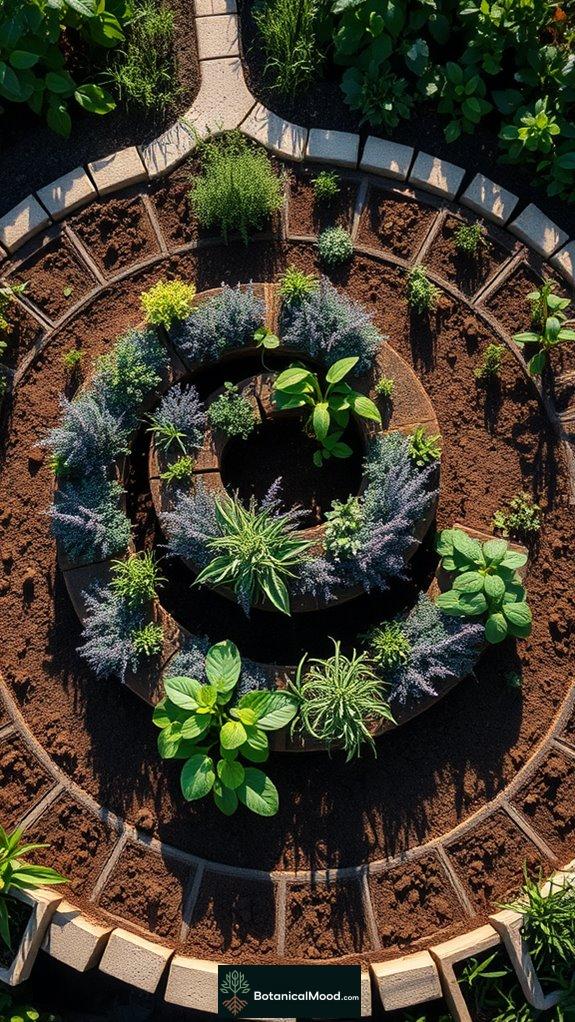
Creating a spiral herb garden not only enhances the beauty of my outdoor space but also promotes a highly functional environment for growing a variety of herbs.
- Microclimates allow me to nurture different herbs based on their sunlight and moisture needs.
- Space efficiency means I can cultivate more herbs in a smaller area.
- Elevated structure provides easy access for maintenance and harvesting.
Crafting this garden design resonates with my passion for gardening, which inspired me to create Botanical Mood. It's a delightful way to blend nature and creativity while enriching my culinary adventures. Additionally, implementing companion planting strategies can further optimize growth and health of my herbs.
Wildlife Habitat Integration
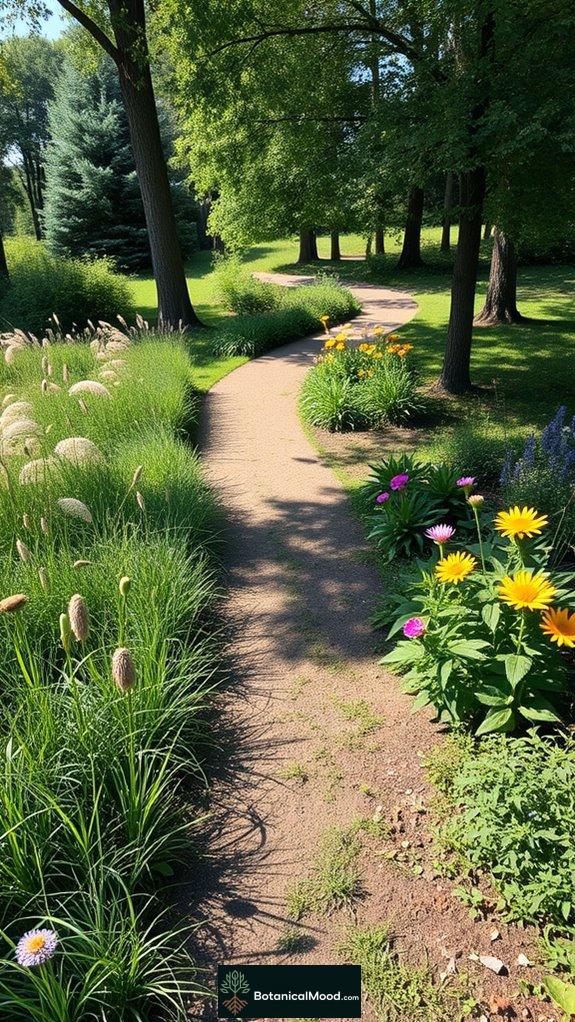
Integrating a wildlife habitat into your garden not only contributes to the beauty of your outdoor space but also fosters a thriving ecosystem that supports diverse species. By focusing on native plants, layered planting, and minimizing pesticides, you can create an inviting refuge for wildlife. Additionally, incorporating bee-friendly plants can significantly enhance the pollinator population in your garden.
| Habitat Type | Key Features |
|---|---|
| Meadow Habitats | Native grasses and flowers |
| Wetland Environments | Elderberry and milkweed |
| Forest Gardens | Tall trees with herbaceous layers |
| Butterfly Gardens | Host plants for caterpillars |
Embracing these elements enhances not just your garden's appeal but also its ecological significance, which is why I created Botanical Mood.
Pollinator-Friendly Garden Plan
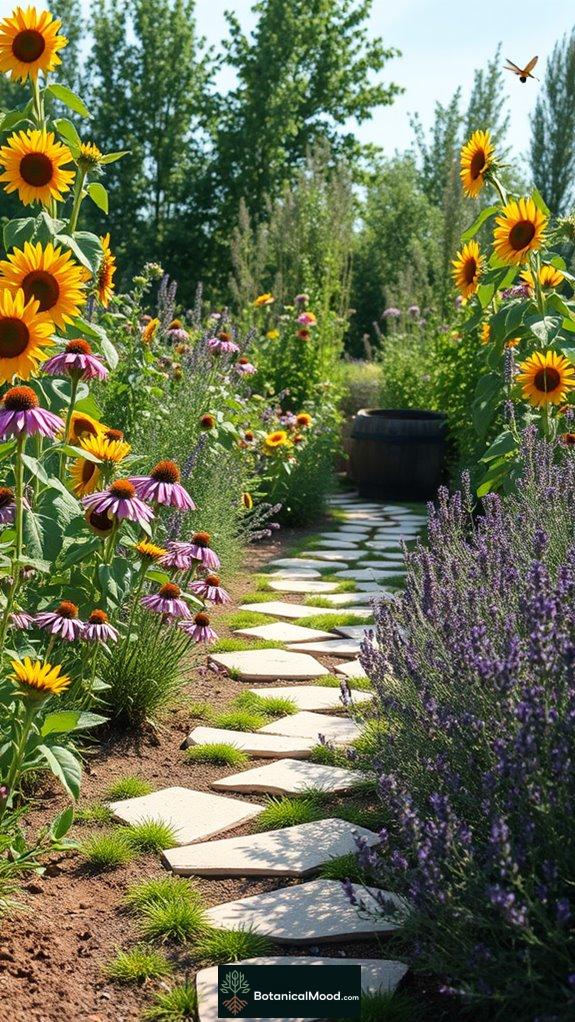
Designing a pollinator-friendly garden not only attracts essential species but also enhances the overall beauty of your outdoor space.
Here are three key elements to take into account:
- Sunny Spot: Pollinators adore full sun, so choose a location that basks in at least six hours of sunlight.
- Native Plants: Incorporate native species to naturally attract local pollinators, providing them with familiar food sources.
- Layered Design: Arrange plants from tallest to shortest, creating visual interest while supporting smaller flora.
Water-Wise Garden Design

As we shift focus from attracting pollinators to conserving water, the concept of a water-wise garden design emerges as an essential approach to sustainable gardening.
By grouping plants with similar water needs and selecting native species, we can greatly reduce water use. Efficient irrigation methods, like drip systems, minimize waste, while mulching helps retain moisture.
Here's a quick guide:
| Principle | Benefit | Example |
|---|---|---|
| Hydrozoning | Efficient watering | Grouping succulents |
| Native Plants | Low water needs | Lavender and sage |
| Mulching | Reduces evaporation | Wood chips or straw |
No-Till Garden Layout
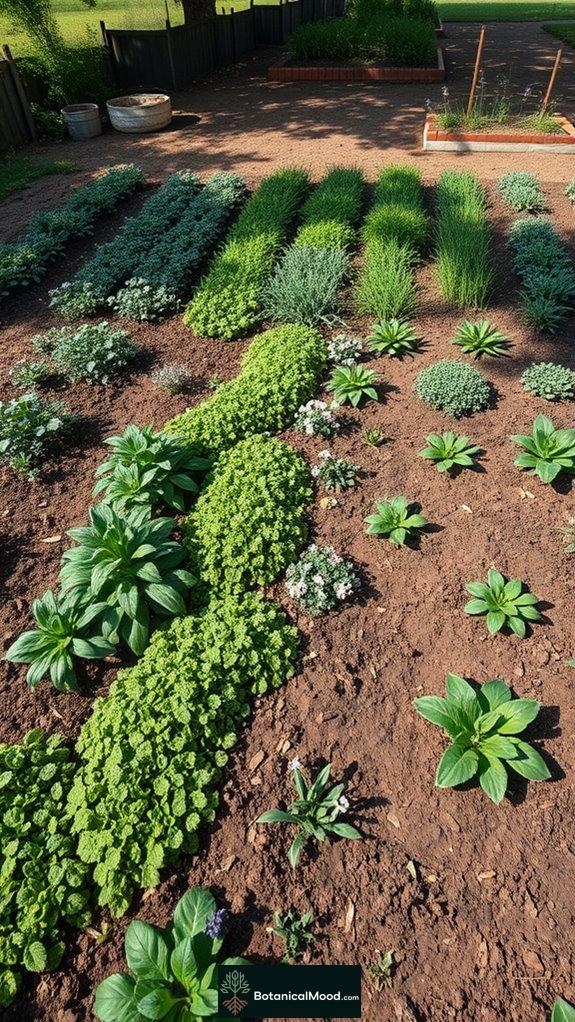
No-till garden layouts offer a rejuvenating approach to gardening, emphasizing the health of the soil while minimizing disruption.
I've found this method truly transformative, nurturing a thriving ecosystem right in my backyard.
Imagine:
- A lush carpet of organic mulch, protecting soil from erosion.
- Vibrant cover crops, enhancing biodiversity and suppressing weeds.
- Rich, crumbly soil, alive with microbial activity, promoting nutrient uptake.
Vertical Garden Solutions
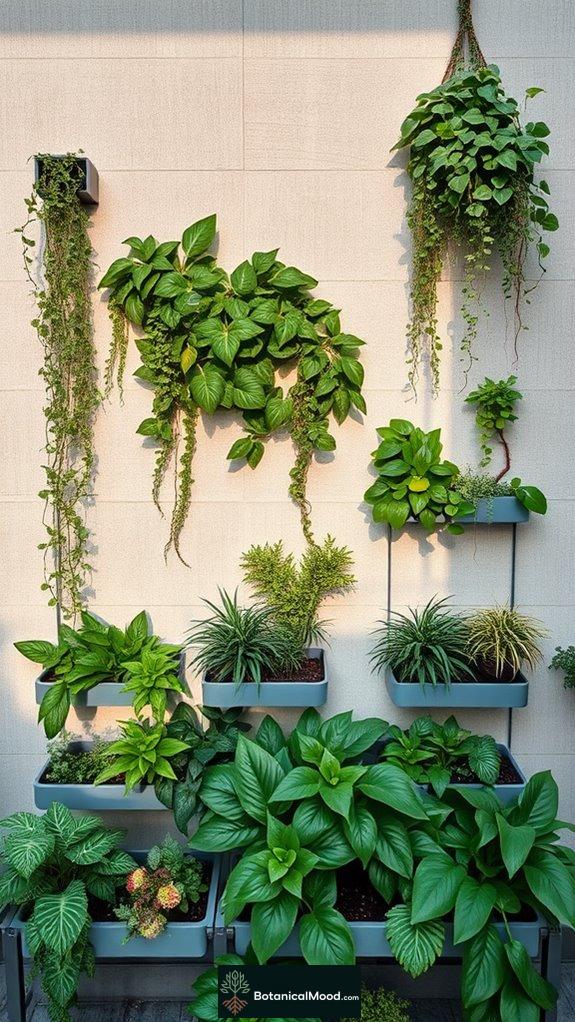
Vertical gardens offer an innovative solution for maximizing space while enhancing the beauty of urban environments.
I love how these gardens transform bare walls into living masterpieces, using a mix of vibrant plants that catch the eye and soothe the soul.
With limited space in cities, vertical gardens create lush retreats, providing natural privacy and improving air quality simultaneously.
Diversity in Planting Patterns

Diversity in planting patterns can create a thriving garden that not only looks stunning but also functions harmoniously within its ecosystem.
By mixing different plant species, I find that:
- Biodiversity flourishes, attracting beneficial insects.
- Soil health improves, thanks to varied root structures.
- Ecosystem services like pollination and pest control thrive.
This thoughtful arrangement reduces my reliance on chemical fertilizers and pesticides, allowing nature to work its magic.
It's a beautiful dance of life, and that's why I created Botanical Mood—to share the joy of crafting gardens that nurture both beauty and balance, creating a sanctuary for all.
Edible Landscape Concepts

Creating a garden that nourishes both the body and the spirit is a rewarding experience.
By integrating edible plants with ornamental elements, I've discovered a beautiful balance that enhances both aesthetics and sustainability. Envision vibrant tomatoes nestled among colorful flowers, providing fresh produce while attracting beneficial insects.
This diversity not only creates seasonal visual interest but also promotes a healthier lifestyle, reducing reliance on store-bought groceries.
Through thoughtful design, I emphasize simplicity and unity, using varied textures and colors to create depth. My passion for these concepts inspired Botanical Mood, where I share my journey toward creating a thriving, edible environment.
Circular Garden Design
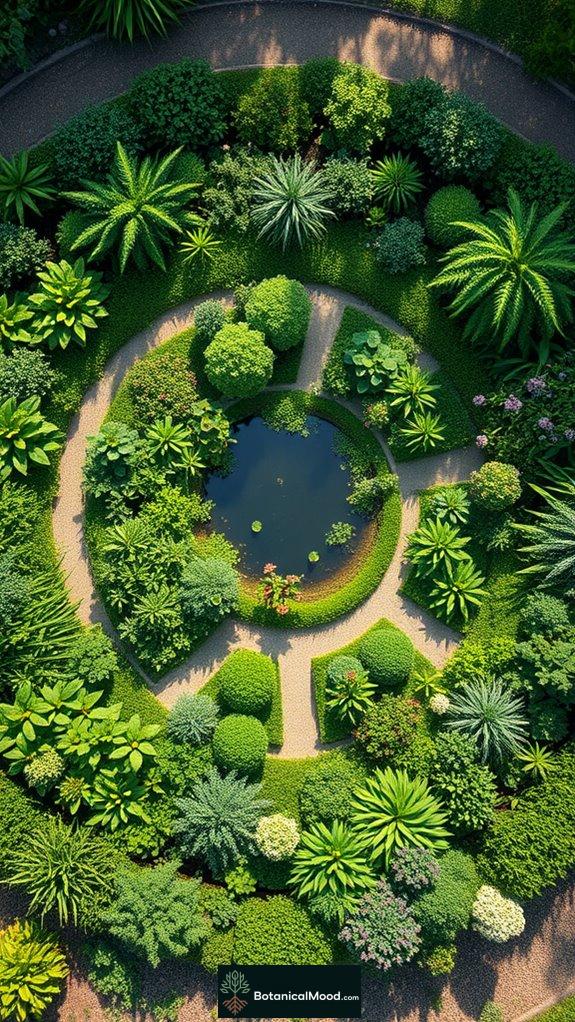
As I explore the enchanting world of circular garden design, I find that this unique layout not only captivates the eye but also serves a multitude of practical purposes.
- The circular shape creates a harmonious flow, making every view feel balanced.
- Efficient use of space allows for dense planting, supporting a vibrant ecosystem.
- Incorporating native plants attracts pollinators, enriching the garden's biodiversity.
This design invites feelings of peace and connection, reminding me why I created Botanical Mood.
Embracing nature through circular gardens brings joy, beauty, and ecological balance to our lives, creating spaces where we can truly thrive.
Biomimicry-Inspired Garden Layout
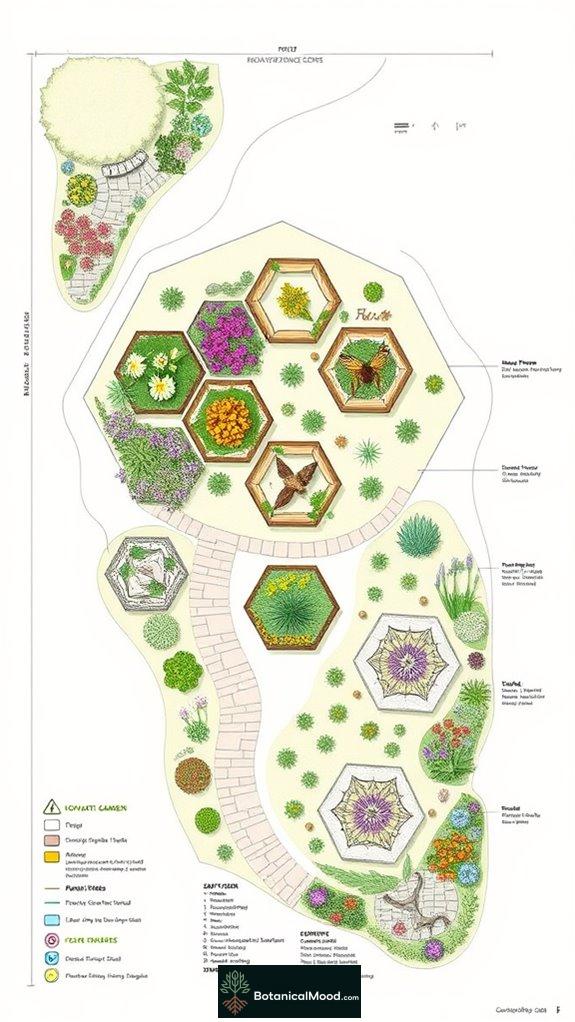
Biomimicry-inspired garden layouts captivate me because they blend nature's genius with human creativity, resulting in spaces that not only look beautiful but also function harmoniously within their ecosystems.
By mimicking efficient patterns found in nature, such as hexagonal structures like those of beehives, I can optimize space while enhancing biodiversity.
Layered planting, similar to natural ecosystems, supports diverse wildlife and improves soil health. This approach encourages sustainable practices, reducing reliance on chemicals, and fosters resilience against climate changes.
Through Botanical Mood, I aim to inspire others to create these enchanting gardens, connecting them deeper with nature's wisdom.
Ecosystem-Based Garden Design

Ecosystem-based garden design thrives on the principle that every element in a garden should contribute to a balanced, self-sustaining environment.
Here are a few key aspects that inspire me:
- Diverse Soil Composition: It nurtures microbial life, enhancing nutrient cycling.
- Native Plant Integration: These plants harmonize with local ecosystems while requiring minimal maintenance.
- Layered Structures: Incorporating trees, shrubs, and groundcovers fosters biodiversity and mimics natural habitats.
Each garden invites beauty and resilience, connecting us more deeply to nature.
Through my website, Botanical Mood, I hope to share these perspectives, guiding you toward creating your own vibrant ecosystem.
Ecosystem-Patterned Garden Design
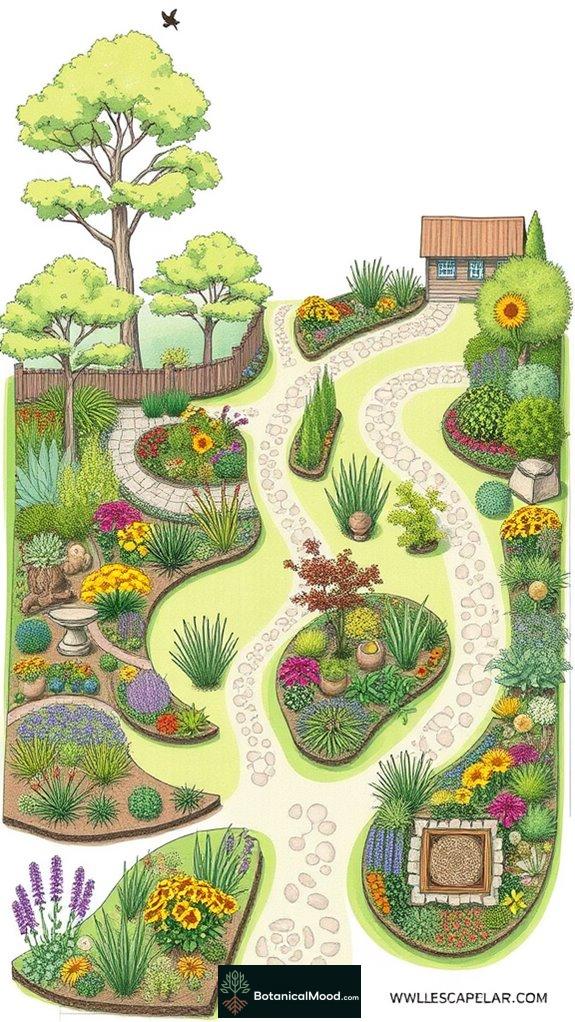
Creating a garden that resonates with the natural world requires an understanding of how ecosystems function, especially when I think about the beauty and complexity they offer.
By incorporating native species and respecting local biodiversity patterns, I can create a sanctuary for wildlife, enhancing the garden's ecological balance.
I focus on soil health through organic matter additions and cover cropping, ensuring a thriving environment.
Layered planting mimics nature, while seasonal blooms attract diverse pollinators.
Each choice reflects my commitment to harmony, which is why I created Botanical Mood, to guide fellow garden lovers in crafting their own ecosystem-patterned paradise.
Garden Zones for Biodiversity

Understanding garden zones is key to fostering biodiversity in our outdoor spaces.
By thoughtfully selecting plants native to our ecoregions, we can create thriving ecosystems that support local wildlife.
Here are three essential strategies for maximizing biodiversity:
- Choose native plants that truly belong in your area, enhancing the connection to your local environment.
- Utilize ecoregion maps to guide your plant choices, ensuring they thrive despite changing climates.
- Create layered plantings that provide various habitats, appealing to a diverse array of creatures.
At Botanical Mood, I cherish this harmony, encouraging you to embrace nature's beauty in your garden.
References
- https://en.wikipedia.org/wiki/Permaculture
- https://www.permaculturegardens.org/design-your-permaculture-garden
- https://content.ces.ncsu.edu/extension-gardener-handbook/appendix-g-permaculture-design
- https://transformativeadventures.org/2017/11/20/what-is-permaculture-a-primer-in-pictures-and-patterns-part-1/
- https://green-connect.com.au/heres-your-guide-to-the-12-principles-of-permaculture/
- https://centerforagroforestry.org/wp-content/uploads/2024/04/08_ForestGardens_TrainingManual_2024Master_0410_Digital-9.pdf
- https://www.thrivelot.com/resources/7-steps-to-build-a-forest-garden-for-wildlife
- https://balkanecologyproject.blogspot.com/2019/02/how-to-design-and-build-forest-garden.html
- https://www.chelseagreen.com/2024/forest-garden/
- https://grocycle.com/forest-garden-design/

Leave a Reply